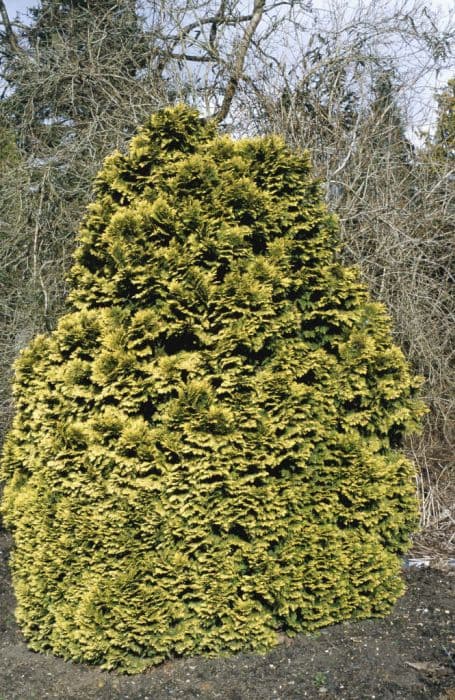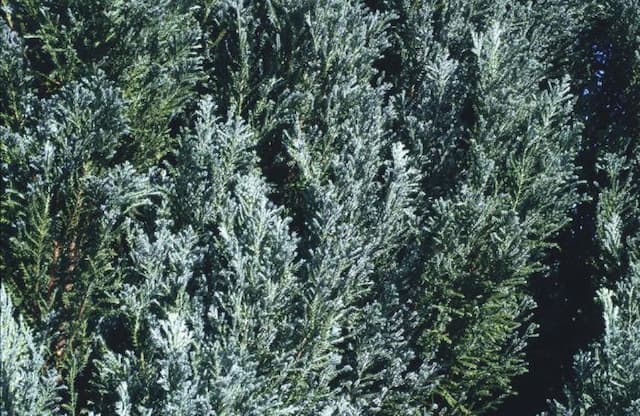Sawara cypress 'Boulevard' Chamaecyparis pisifera 'Boulevard'

ABOUT
'Boulevard' is an evergreen conifer forming a large, dense conical shrub to 8m, with soft, silvery blue-grey foliage, often tinged purple in winter. More attractive when young
About this plant
 Names
NamesFamily
Cupressaceae
Synonyms
Boulevard Cypress, Blue Moss Cypress, Japanese False Cypress
Common names
Retinispora pisifera, Cupressus pisifera.
 Characteristics
CharacteristicsLife cycle
Perennials
Foliage type
Evergreen
Color of leaves
Blue-green
Height
10-15 feet (3-4.6 meters)
Spread
4-6 feet (1.2-1.8 meters)
Plant type
Tree
Hardiness zones
4-8
Native area
Japan
Benefits
 General Benefits
General Benefits- Ornamental Value: Boulevard Cypress adds aesthetic appeal to gardens with its attractive blue-green foliage and conical shape.
- Low Maintenance: It requires minimal care once established, making it ideal for gardeners seeking low-maintenance landscaping options.
- Drought Tolerance: This plant is relatively drought-tolerant, making it suitable for regions with less frequent rainfall once it is well-established.
- Cold Hardiness: It can endure cold temperatures, which is beneficial for gardens in regions with harsh winters.
- Pest Resistance: Boulevard Cypress shows resistance to many pests, which can help reduce the need for chemical treatments in the garden.
- Privacy Screen: With its dense growth habit, it can serve as a natural privacy screen or windbreak when planted in rows.
- Erosion Control: The root system can help stabilize soil and prevent erosion on slopes and banks.
- Wildlife Habitat: It provides shelter and nesting sites for birds and other wildlife, enhancing biodiversity.
- Longevity: This species is known for its longevity, contributing to a stable and lasting garden structure.
- Versatility: It can be used in a variety of landscape designs, including formal gardens, rock gardens, or as a stand-alone specimen.
 Medical Properties
Medical PropertiesThis plant is not used for medical purposes.
 Air-purifying Qualities
Air-purifying QualitiesThis plant is not specifically known for air purifying qualities.
 Other Uses
Other Uses- The 'Boulevard' Cypress can be shaped into topiary art, creating live sculptures for gardens and landscapes.
- Its fine-textured foliage can be used as a soft, natural backdrop for photographing smaller plants and garden features.
- Dried foliage of the 'Boulevard' Cypress can be added to potpourri mixes for a subtle woody scent.
- Woodworkers may use the fragrant wood of mature plants for small woodworking projects like crafting ornamental boxes.
- This plant can be used in miniature train sets and model landscapes as a representation of larger trees due to its scale-like appearance.
- 'Boulevard' Cypress clippings can be used to create natural wreaths and garlands for holiday decorations.
- 'Boulevard' Cypress provides excellent cover and nesting opportunities for small birds when allowed to grow densely.
- The tree can be used as a privacy screen when planted in a row, blocking unwanted views and noise.
- In coastal areas, 'Boulevard' Cypress can be planted as windbreaks, offering protection for other plants from sea breezes.
- When planted in outdoor meeting spaces or patios, the 'Boulevard' Cypress can serve as a natural sound dampener, creating a quieter and more tranquil setting.
Interesting Facts
 Feng Shui
Feng ShuiThe Boulevard Cypress is not used in Feng Shui practice.
 Zodiac Sign Compitability
Zodiac Sign CompitabilityThe Boulevard Cypress is not used in astrology practice.
 Plant Symbolism
Plant Symbolism- Longevity: The Boulevard Cypress, as an evergreen tree, symbolizes long life and eternal growth due to its ability to remain green throughout the year.
- Strength: It's a hardy conifer, which signifies resilience and the ability to withstand adverse conditions, representing inner strength.
- Sanctuary: This plant offers a sense of protection and privacy with its dense foliage, thus symbolizing a safe haven or sanctuary.
- Peace: The soft texture and calming blue-green color of the Boulevard Cypress can evoke a sense of tranquility and peace.
- Healing: Like many evergreens, it’s sometimes associated with restorative and healing properties, both physically and spiritually.
 Water
WaterThe Boulevard Cypress should be watered deeply and less frequently to encourage root growth—aim for about once a week, adjusting for rainfall and temperature. During hot, dry periods, water every 3-5 days. For established plants, provide about 1 to 1.5 gallons of water per watering session. Adjust the amount during the winter, when the plant needs less moisture due to dormancy. Always check the soil before watering; it should be moist but not saturated.
 Light
LightBoulevard Cypress prefers full sun to partial shade, thriving in a spot that receives at least 4-6 hours of direct sunlight daily. The ideal location is where it can bask in the morning light and be protected from the harsh afternoon sun.
 Temperature
TemperatureBoulevard Cypress is hardy and can withstand temperatures as low as -20°F and as high as 80°F. The ideal temperature range for the plant is between 60°F and 70°F. Sudden drops in temperature or prolonged exposure to heat outside of these ranges should be avoided.
 Pruning
PruningPrune Boulevard Cypress to shape and maintain its size in late winter or early spring, before the onset of new growth. Pruning at this time allows wounds to heal before the growing season. Light pruning for shaping can be done throughout the growing season, but major cuts should be done during dormancy. It doesn't require frequent pruning; once a year is typically enough unless shaping is desired.
 Cleaning
CleaningAs needed
 Soil
SoilThe best soil mix for the Boulevard Cypress should be well-draining with a mixture of peat, compost, and pine bark. The soil pH should be slightly acidic, ideally between 5.0 to 6.0.
 Repotting
RepottingBoulevard Cypress generally needs repotting every two to three years to prevent it from becoming root-bound and to refresh the soil.
 Humidity & Misting
Humidity & MistingBoulevard Cypress thrives in moderate humidity levels. It is adaptable but prefers a range of 40% to 60% humidity for optimal growth.
 Suitable locations
Suitable locationsIndoor
Place in bright, indirect light, ensure good airflow, don't overheat.
Outdoor
Use well-draining soil, full sun to partial shade, shelter from wind.
Hardiness zone
4-8 USDA
 Life cycle
Life cycleThe Boulevard cypress (Chamaecyparis pisifera 'Boulevard') starts its life as a seed, which germinates in spring after a period of cool, moist stratification to break dormancy. The seedling stage is characterized by initial root and shoot development, during which the plant is highly vulnerable to environmental conditions. As it enters the juvenile phase, the Boulevard cypress develops its trademark soft, blue-green, feathery foliage and starts to exhibit the slow-growing, conical shape typical of mature plants. During the mature stage, this ornamental conifer will continue to grow slowly, reaching up to 12 feet tall and 4 to 5 feet wide, and can begin reproductive processes, producing small cones after several years. Towards the end of its life, which can span several decades, the plant's growth rate declines, and it may become more susceptible to disease and environmental stressors. After the reproduction stage persists and the plant ages, it will eventually die, completing its life cycle by potentially leaving behind seeds that will give rise to new Boulevard cypress plants.
 Propogation
PropogationPropogation time
Spring to early summer
The most popular method for propagating the Boulevard Cypress, scientifically named Chamaecyparis pisifera 'Boulevard', is through semi-hardwood cuttings. This technique involves taking cuttings from current year's growth in the late summer to early autumn. You would cut a 4 to 6-inch (10 to 15 cm) piece of semi-hardwood stem, strip off the lower foliage, and treat the cut end with rooting hormone to encourage root development. It is then inserted into a well-draining potting mixture and kept in a humid environment until roots develop, which can take several weeks to a few months. It is important to keep the cutting out of direct sunlight and to maintain consistent moisture without overwatering to prevent rot. Once rooted, the new plants can be gradually acclimated to outdoor conditions and eventually planted in their permanent locations.









